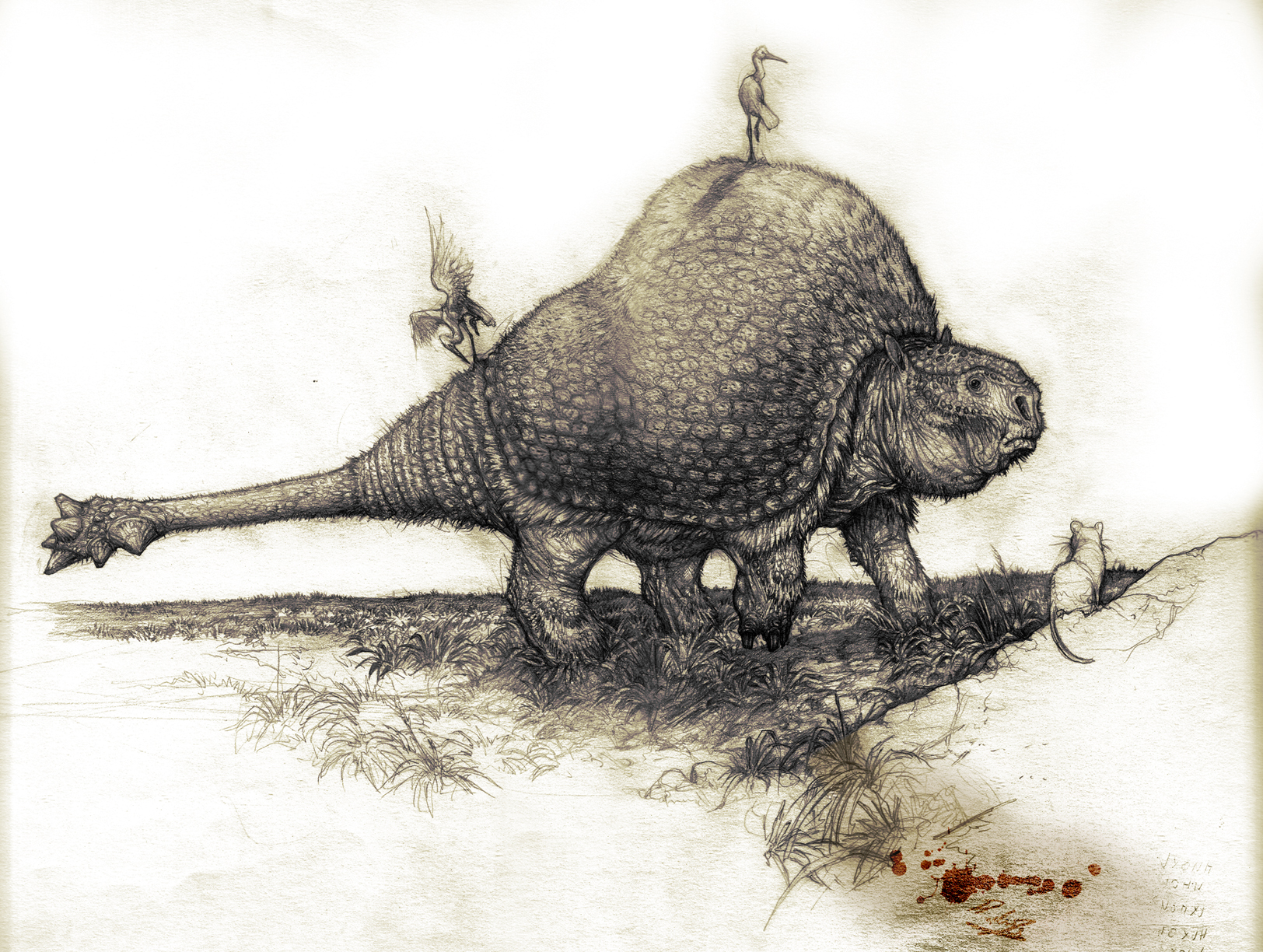Post by Infinity Blade on Apr 11, 2015 19:29:52 GMT 5
Doedicurus clavicaudatus

© @ Rodrigo-Vega
Temporal range: Pleistocene (0.781-0.0117Ma)
Scientific classification:
Domain: Eukaryota
(unranked): Unikonta
(unranked): Opisthokonta
(unranked): Holozoa
(unranked): Filozoa
Kingdom: Animalia
Subkingdom: Eumetazoa
(unranked): Bilateria
Superphylum: Deuterostomia
Phylum: Chordata
Infraphylum: Gnathostomata
Clade: Eugnathostomata
Clade: Teleostomi
Superclass: Tetrapoda
Clade: Reptiliomorpha
Clade: Amniota
Clade: Synapsida
Clade: Eupelycosauria
Clade: Sphenacodontia
Clade: Sphenacodontoidea
Order: Therapsida
Suborder: Cynodontia
Clade: Prozostrodontia
Clade: Mammaliaformes
Class: Mammalia
Legion: Cladotheria
Sublegion: Zatheria
Infralegion: Tribosphenida
Subclass: Theria
Clade: Eutheria
Infraclass: Placentalia
Subcohort: Exafroplacentalia
Superorder: Xenarthra
Order: Cingulata
Family: Chlamyphoridae (Delsuc et al., 2016)
Subfamily: †Glyptodontinae (Delsuc et al., 2016)
Genus: †Doedicurus
Species: †D. clavicaudatus
Doedicurus clavicaudatus ("pestle tail") is an extinct species of glyptodont that lived in South America from the Pleistocene to the very end thereof. Doedicurus is one of the most well-known Pleistocene megafauna. Like all glyptodonts, Doedicurus was herbivorous. It was estimated to have weighed ~1,900-2,370 kilograms.[1] The glyptodont's girth was covered with a huge round carapace and the bony armor around the tail region was flexible in order to allow Doedicurus to swing its tail. Another one of the most notable features of Doedicurus was the spiked distal end of its tail. Some Doedicurus specimens had carapaces with evidence that they were hit by the tails of conspecifics, providing direct evidence that they were used in intraspecific conflict. Likewise, there was even a layer of fat underneath the carapace to help cushion tail blows. Despite this, the tail would supposedly have been of limited use as a defensive weapon against predators, as the glyptodont's field of vision was apparently too limited to the extent that it would have to blindly swing its tail.[2]
References:
[1] www.sbpbrasil.org/revista/edicoes/15_1/9_Soibelzon_et_al.pdf
[2] "Tail blow energy and carapace fractures in a large glyptodont (Mammalia, Xenarthra)" (Alexander et al., 1999).

© @ Rodrigo-Vega
Temporal range: Pleistocene (0.781-0.0117Ma)
Scientific classification:
Domain: Eukaryota
(unranked): Unikonta
(unranked): Opisthokonta
(unranked): Holozoa
(unranked): Filozoa
Kingdom: Animalia
Subkingdom: Eumetazoa
(unranked): Bilateria
Superphylum: Deuterostomia
Phylum: Chordata
Infraphylum: Gnathostomata
Clade: Eugnathostomata
Clade: Teleostomi
Superclass: Tetrapoda
Clade: Reptiliomorpha
Clade: Amniota
Clade: Synapsida
Clade: Eupelycosauria
Clade: Sphenacodontia
Clade: Sphenacodontoidea
Order: Therapsida
Suborder: Cynodontia
Clade: Prozostrodontia
Clade: Mammaliaformes
Class: Mammalia
Legion: Cladotheria
Sublegion: Zatheria
Infralegion: Tribosphenida
Subclass: Theria
Clade: Eutheria
Infraclass: Placentalia
Subcohort: Exafroplacentalia
Superorder: Xenarthra
Order: Cingulata
Family: Chlamyphoridae (Delsuc et al., 2016)
Subfamily: †Glyptodontinae (Delsuc et al., 2016)
Genus: †Doedicurus
Species: †D. clavicaudatus
Doedicurus clavicaudatus ("pestle tail") is an extinct species of glyptodont that lived in South America from the Pleistocene to the very end thereof. Doedicurus is one of the most well-known Pleistocene megafauna. Like all glyptodonts, Doedicurus was herbivorous. It was estimated to have weighed ~1,900-2,370 kilograms.[1] The glyptodont's girth was covered with a huge round carapace and the bony armor around the tail region was flexible in order to allow Doedicurus to swing its tail. Another one of the most notable features of Doedicurus was the spiked distal end of its tail. Some Doedicurus specimens had carapaces with evidence that they were hit by the tails of conspecifics, providing direct evidence that they were used in intraspecific conflict. Likewise, there was even a layer of fat underneath the carapace to help cushion tail blows. Despite this, the tail would supposedly have been of limited use as a defensive weapon against predators, as the glyptodont's field of vision was apparently too limited to the extent that it would have to blindly swing its tail.[2]
References:
[1] www.sbpbrasil.org/revista/edicoes/15_1/9_Soibelzon_et_al.pdf
[2] "Tail blow energy and carapace fractures in a large glyptodont (Mammalia, Xenarthra)" (Alexander et al., 1999).



